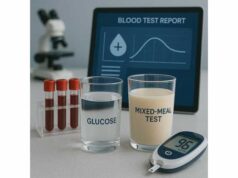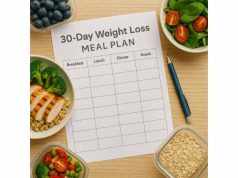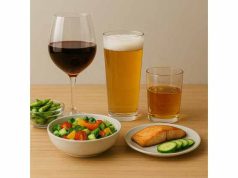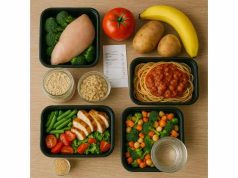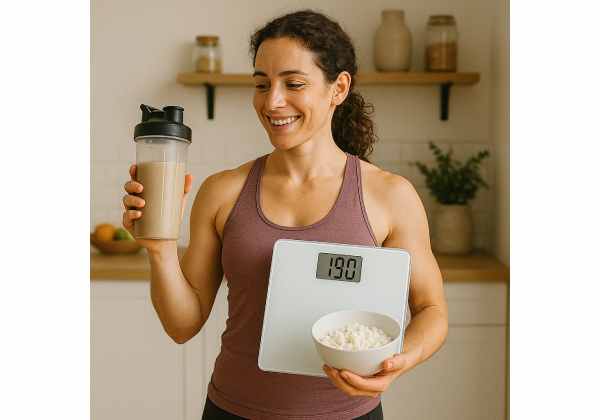
Hitting the right protein intake makes fat loss easier. You feel fuller between meals, keep more lean muscle while dieting, and avoid the energy dips that drive snacking. This guide translates research into clear daily targets based on your body weight, plus simple meal templates and food choices that fit a busy life. We will show you how to set grams per day, spread them across meals, and adjust for training, age, and appetite. If you also want a full framework for calories, macros, and planning, see our overview of calorie goals and meal planning. The aim is practical: choose numbers you can live with, then build easy habits around them.
Table of Contents
- Protein intake for weight loss
- Grams per day by body weight
- Protein timing and distribution
- Best protein sources and portions
- Mistakes and troubleshooting
- Safety and special cases
- Evidence summary and action plan
- Frequently Asked Questions
Protein intake for weight loss
Protein is the linchpin of an effective fat loss plan. When calories drop, your body looks for energy wherever it can find it. A higher protein intake protects lean tissue, which helps maintain your resting metabolic rate and makes the scale changes mostly fat, not muscle. Protein also has the highest thermic effect of food: roughly 20–30% of protein calories are used just to digest and process the amino acids. That is not a magic trick, but it does make a real, cumulative difference over weeks and months.
Satiety is the other reason protein works. Meals with adequate protein lead to steadier appetite hormones and slower gastric emptying. Practically, that means fewer “bottomless” evenings and a lot less grazing. Many people notice they can drop total calories by 200–400 per day simply by anchoring each meal with a solid protein portion and keeping snacks protein-forward.
“How much is enough?” For most people cutting weight, a daily range of 1.6–2.2 grams per kilogram of goal body weight (about 0.7–1.0 grams per pound) strikes the right balance between results and practicality. Within that range, you will tailor up or down based on body size, training volume, age, and preference. Going far above 2.2 g/kg rarely adds meaningful benefits for fat loss; dropping far below 1.2–1.4 g/kg makes it harder to control hunger and keep muscle.
Protein does not work alone. It is one part of a system that also includes a calorie deficit, fiber-rich carbohydrates, and enough dietary fat for hormones and satisfaction. If you need a refresher on setting a safe deficit and building balanced meals, skim our guide to safe weight-loss basics before you set your numbers.
Last, remember that adherence beats perfection. A plan that delivers 90% of your target most days will outperform an “ideal” plan that collapses by Thursday. Choose a number you can hit consistently, then build meals that make that number feel easy.
Grams per day by body weight
Here is how to set your daily protein target in minutes.
Step 1: Choose a reference weight.
- If you are within about 10–15% of your desired size, use your current body weight.
- If you carry significantly more body fat, use your goal body weight or a midpoint you could reasonably reach in 6–12 months. This prevents unrealistic gram targets.
Step 2: Pick a range.
- General fat loss: 1.6–2.2 g/kg (0.7–1.0 g/lb).
- Very active or strength training 3–5 days/week: 1.8–2.4 g/kg (0.8–1.1 g/lb).
- Older adults (55+), cutting weight: aim toward the upper half of the range for muscle retention.
- Vegetarian or vegan: same targets, but favor high-quality plant proteins and slightly higher totals if most choices are lower in leucine.
Step 3: Convert to meals.
Divide your daily total across 3–5 eating occasions, aiming for 25–40 g per meal and 10–25 g at snacks. Spreading protein like this supports muscle protein synthesis and controls hunger between meals.
Quick reference table (use goal weight if cutting from a higher weight)
| Body weight | Protein/day at 1.6 g/kg | Protein/day at 2.2 g/kg |
|---|---|---|
| 60 kg (132 lb) | 95 g | 132 g |
| 70 kg (154 lb) | 112 g | 154 g |
| 80 kg (176 lb) | 128 g | 176 g |
| 90 kg (198 lb) | 144 g | 198 g |
| 100 kg (220 lb) | 160 g | 220 g |
| 120 kg (265 lb) | 192 g | 264 g |
Worked examples
- Office worker, light training: 75 kg goal weight × 1.6 g/kg = 120 g/day. Four meals of ~30 g each.
- Runner lifting twice weekly: 68 kg × 1.8 g/kg = 122 g/day. Three meals at 30–35 g plus a 20–25 g snack.
- Strength trainee, cutting: 85 kg × 2.2 g/kg = 187 g/day. Four meals at ~40–45 g plus a 20 g snack.
Your protein target must live inside your calories. If you have not set a daily calorie range yet, start there and then place protein within that budget using our guide to macro ratios.
Adjusting over time
- If hunger is high and adherence is shaky, push protein toward the upper end and raise fiber.
- If you feel stuffed or calories are too tight, hold protein steady but reduce added fats first, then refine carb choices to higher fiber per calorie.
- If training volume jumps, keep protein constant and add carbohydrates around workouts.
Protein timing and distribution
Timing does not override your daily total, but distribution shapes how that total feels. A lopsided day—10 g at breakfast, 20 g at lunch, 90 g at dinner—leaves long hunger gaps and misses repeated stimulation of muscle protein synthesis. Even spacing delivers steadier energy, fewer cravings, and better body composition.
Aim for a minimum dose at each eating occasion.
Most adults benefit from 25–40 grams of high-quality protein at meals. This range reliably delivers enough leucine (an amino acid that signals muscle building) to flip the “on” switch for repair and maintenance. Snacks can be lighter—10–25 grams—as bridges between meals.
Match timing to your day
- Morning: A protein-anchored breakfast reduces late-day snacking. Plain Greek yogurt with fruit, eggs with vegetables, or a tofu scramble are fast wins. For ideas you can make in minutes, browse our list of high-protein breakfasts.
- Pre-workout (60–120 minutes): Choose easily digested protein with moderate carbs—yogurt and fruit, cottage cheese and pineapple, or a small shake and a banana.
- Post-workout (within a few hours): Any regular meal with 25–40 g protein works; the “anabolic window” is larger than once thought, but do not delay for many hours if you trained hard.
- Evening: A protein-forward dinner plus an optional small protein snack (like skyr or cottage cheese) can reduce late-night hunger without overshooting calories.
Example distributions
- Three meals: 35 g breakfast, 35 g lunch, 50 g dinner = 120 g/day.
- Three meals + snack: 30–30–40 g meals + 20 g snack = 120 g/day.
- Four meals: 30 g × 4 = 120 g/day when you prefer smaller portions.
Protein shakes: when and how
Shakes are tools, not requirements. Use them when real food is impractical or appetite is low. A scoop of whey (or soy/pea blend) in water or milk provides 20–30 g quickly; pair with fruit or a small handful of nuts for balance. On days you rely on shakes, ensure your other meals include vegetables, legumes, and whole grains to cover nutrients and fiber.
Travel and busy seasons
Travel days, long shifts, and conferences are when a protein plan pays off. Pack shelf-stable options—tuna pouches, jerky, roasted edamame, or UHT milk cartons—to avoid low-protein, high-calorie defaults. A little planning protects your deficit without feeling restricted.
Best protein sources and portions
You do not need complicated recipes to hit your target—just reliable sources you enjoy and can rotate. Build your day with a mix of dairy, eggs, poultry, fish, lean meats, tofu, tempeh, legumes, and strategic convenience items. The goal is protein density (more protein per calorie) alongside flavor and practicality.
High-protein, high-satiety staples
- Greek yogurt or skyr (plain): ~17–20 g per 170 g (6 oz). Add berries, cinnamon, or a drizzle of honey if needed.
- Cottage cheese (low-fat): ~20–24 g per ¾ cup. Savory with cucumber and pepper or sweet with fruit.
- Eggs: ~6–7 g per egg. Two to three with vegetables is an easy breakfast.
- Chicken or turkey breast: ~25–30 g per 100 g cooked. Roast extra for the week.
- White fish (cod, haddock) and shrimp: ~20–24 g per 100 g, very low calorie.
- Salmon, trout, sardines: ~20–25 g per 100 g plus omega-3 fats for health and satiety.
- Tofu or tempeh: ~12–20 g per 100 g. Press tofu for better texture; pan-sear with minimal oil.
- Lentils, beans, chickpeas: ~7–10 g per ½ cup cooked; combine with grains or add a small portion of dairy or tofu to raise total protein.
- Roasted edamame or soy crisps: ~10–15 g per 25–30 g handful; perfect for desks and travel.
- Protein powders (whey, soy, pea blends): 20–30 g per scoop.
Portion templates
- Quick 30 g: 170 g Greek yogurt + ½ cup berries + 10 g nuts.
- Quick 40 g: ¾ cup cottage cheese + 2 eggs + tomatoes.
- Plant 30–35 g: 150 g tofu stir-fry + ½ cup edamame + vegetables.
- Fish 35–45 g: 150–180 g baked salmon + salad and potatoes.
Pack your week efficiently
- Cook double protein at dinner for tomorrow’s lunch.
- Keep “default combos” on a fridge note: yogurt bowl, egg-and-veg pan, tuna-and-crispbread, lentil salad cup.
- Use spices, citrus, and pickled vegetables to add flavor without many calories.
For an expanded list with serving sizes you can print, see our high-protein foods list and pull 5–7 options you actually like. Consistency beats novelty.
Mistakes and troubleshooting
Even good plans can stall. Here are common protein pitfalls and precise fixes.
Mistake 1: Hitting the total, missing the distribution.
Loading most protein at dinner leaves long hunger gaps and weakens muscle retention signals.
Fix: Aim for 25–40 g at each meal. If breakfast is hard, use Greek yogurt, eggs, or a small shake to reach the minimum dose.
Mistake 2: Chasing “protein” on labels that are mostly fats or sugars.
Bars and yogurts can vary wildly.
Fix: Look for ≥10 g protein per 100 calories as a quick heuristic. Choose plain yogurt and add fruit; pick bars with a short ingredient list and strong protein-to-calorie ratio.
Mistake 3: Ignoring fiber and carbs.
High-protein with too little fiber leads to low satisfaction and constipation.
Fix: Add beans, lentils, whole grains, fruit, and vegetables around protein anchors. If appetite is high, explore our high-volume, low-calorie foods to stretch fullness.
Mistake 4: Over-relying on shakes.
Shakes are convenient but can crowd out whole-food nutrients.
Fix: Cap shakes at 1–2 per day. Pair with fruit or a small serving of nuts; let meals handle the rest.
Mistake 5: Under-eating fat.
Ultra-lean days can feel joyless and lead to binges.
Fix: Keep measured portions of olive oil, avocado, nuts, and eggs. Dietary fat supports hormones and satiety even in a cut.
Mistake 6: Not matching protein to training.
Hard sessions without adequate protein feel flat and slow recovery.
Fix: On heavy training days, ensure a meal or snack with 25–40 g protein within a few hours post-workout and enough carbs to refuel.
Mistake 7: Sticking to one or two foods.
Monotony erodes adherence.
Fix: Rotate three breakfasts, three lunches, and five dinners you like. Small variety preserves enjoyment without complicating shopping.
If the scale stalls for two weeks, check: (1) calorie adherence; (2) protein distribution; (3) fiber intake; (4) weekend creep. Fix the weakest link first.
Safety and special cases
For most healthy adults, higher-protein diets during weight loss are safe and well tolerated. Still, personal context matters. When in doubt, speak with your clinician—especially if you have a medical condition or take medications.
Kidney health
In people with normal kidney function, protein intakes in the ranges discussed do not harm kidneys. If you have chronic kidney disease or reduced kidney function, your protein needs are individualized and often lower; follow your nephrology team’s guidance.
Liver health and gallbladder issues
If you have active liver disease or a recent gallbladder event, discuss protein and fat targets with your clinician. Many patients do well with moderate protein and a gradual fat reintroduction after medical clearance.
Gout
Purine-rich foods can trigger flares in susceptible individuals. Many high-protein foods are fine, but monitor portion sizes of certain meats and seafood. Hydration and steady weight loss help; review our guide to hydration strategies for practical tips.
Pregnancy and breastfeeding
Weight loss is not usually advised in pregnancy. Protein needs are higher, but goals shift from “cutting” to nourishment. If breastfeeding and returning to pre-pregnancy weight, use a conservative deficit and protein at the lower to middle of our ranges unless advised otherwise.
Older adults (55+)
Age-related anabolic resistance means you need more protein to achieve the same effect. Aim for 1.8–2.2 g/kg if cutting, with 30–40 g at meals and resistance training two to three days per week to protect strength.
Vegetarian and vegan patterns
You can meet the same targets with planning. Combine legumes, soy foods (tofu, tempeh, edamame), seitan, and higher-protein grains (quinoa, buckwheat). Consider a soy or pea-blend protein powder to simplify distribution and hit per-meal minimums.
GI comfort
Rapid jumps in protein—especially with lots of dairy or sweeteners—can cause bloating. Increase gradually, rotate sources, and keep fiber and fluids adequate to support digestion.
Evidence summary and action plan
Across dozens of controlled trials, higher-protein diets during energy restriction lead to greater fat loss, better lean mass retention, and improved satiety compared with lower-protein diets at the same calories. The most practical takeaway is simple: for most adults, 1.6–2.2 g/kg per day, distributed across meals, works consistently well.
The plan below turns those findings into steps you can start this week.
Step 1: Pick your number
Choose 1.6–2.2 g/kg of goal body weight. Write it down. Example: 72 kg goal × 1.8 = 130 g/day.
Step 2: Distribute it
Decide on 3–4 meals and optionally 1 snack. For 130 g/day: 35 g breakfast, 35 g lunch, 40 g dinner, 20 g snack.
Step 3: Stock your defaults
Buy a week of anchors: Greek yogurt, cottage cheese, eggs, chicken or tofu, tuna pouches, lentils, frozen berries, vegetables, whole-grain crispbreads. Batch-cook two proteins; prep a lentil salad; boil a dozen eggs.
Step 4: Use simple meal templates
- Breakfast: eggs and vegetables with toast; or yogurt bowl with fruit and nuts (30–40 g).
- Lunch: big salad with chicken, beans, and light dressing (30–40 g).
- Dinner: fish or tofu, potatoes or rice, and vegetables (35–45 g).
- Snack: skyr, edamame, or a small shake with fruit (10–25 g).
Step 5: Adjust by feel
- Hungry between meals? Raise per-meal protein by 5–10 g and add a fist of vegetables or beans.
- Too full or calories tight? Hold protein steady, trim added fats, and swap refined carbs for higher-fiber options.
- Training harder? Keep protein stable and add 15–30 g carbs pre- and post-workout.
Step 6: Track the trend
Weigh 2–4 times weekly, average the numbers, and adjust calories if the 14-day trend stalls. Keep protein consistent while you modify energy intake.
This approach is deliberately boring—in the best way. Clear numbers, repeatable meals, and a short shopping list remove friction so you can be consistent.
Frequently Asked Questions
How many grams of protein per day should I eat to lose weight?
Most adults do well with 1.6–2.2 g/kg of goal body weight (0.7–1.0 g/lb). Choose a number you can sustain, then distribute it across 3–5 eating occasions. Aim for 25–40 g at meals and 10–25 g at snacks to control hunger and protect muscle.
Is more than 2.2 g/kg of protein better for fat loss?
Going above 2.2 g/kg rarely improves fat loss or muscle retention for most people and can crowd out fiber and micronutrients. Focus on consistency at a workable target, adequate calories for your goal, and high-quality foods rather than chasing extreme numbers.
What are easy ways to hit my protein if I am busy?
Keep “default” options: Greek yogurt cups, cottage cheese, tuna pouches, eggs, tofu, jerky, roasted edamame, and a quality protein powder. Pair with fruit or vegetables. Batch-cook chicken or lentils and build simple meals around them during the week.
Do I need protein after every workout?
You do not need an immediate shake, but aim to eat 25–40 g of protein within a few hours after training. Any regular meal works. On heavy days, include moderate carbohydrates to refuel so you recover well and can maintain training quality.
Can a vegetarian or vegan hit these protein targets?
Yes. Use tofu, tempeh, edamame, lentils, beans, seitan, higher-protein grains, and a soy or pea-blend protein powder if helpful. Keep per-meal protein in the 25–40 g range and combine legumes with soy foods to improve amino acid profiles.
Is high protein safe for my kidneys?
For healthy adults with normal kidney function, higher-protein intakes in these ranges are considered safe. If you have chronic kidney disease or reduced kidney function, protein needs are individualized; speak with your clinician for specific guidance before changing your diet.
References
- Impacts of protein quantity and distribution on body composition (2024) (Review)
- Effects of Varying Protein Amounts and Types on Diet-Induced Thermogenesis: A Systematic Review and Meta-Analysis (2024) (Systematic Review & Meta-analysis)
- Protein intake and body weight, fat mass and waist circumference: an umbrella review of systematic reviews for the evidence-based guideline on protein intake of the German Nutrition Society (2023) (Umbrella Review)
- Systematic review and meta‐analysis of protein intake to support muscle mass and function in healthy adults (2022) (Systematic Review & Meta-analysis)
- Clinical Evidence and Mechanisms of High-Protein Diet-Induced Weight Loss (2020) (Review)
Disclaimer
This article provides general nutrition guidance for adults pursuing weight loss. It does not replace personalized medical advice, diagnosis, or treatment. If you have a medical condition, take prescription medications, are pregnant, or are breastfeeding, consult your healthcare professional before changing your diet or exercise routine.
Share and follow
If this guide helped you set clear protein targets, please share it with a friend who is planning meals. For steady, research-based tips, follow us on the social network you use most.

